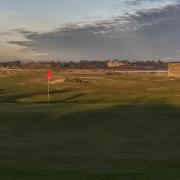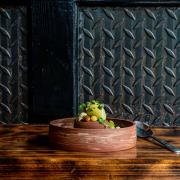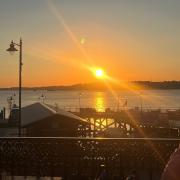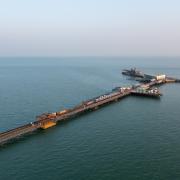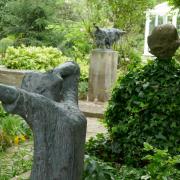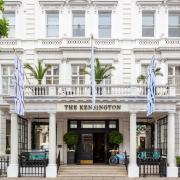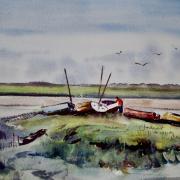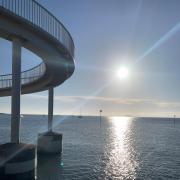Essex has one of the longest coastlines in England. Andrew Millham set out to travel the entirety of it by boat. Here, he shares his journey with us
To complete this journey, which was undertaken as a fundraiser for the RNLI, my aim was to enlist the help of local sailing clubs along the coastline. It was a logistical challenge, totalling nine days of travel in a variety of vessels, and I was frequently overwhelmed by the endless generosity of the Essex folk who live by the sea. It would not have been possible without them.

Day One – Thurrock to Leigh-on-Sea
Time and tide wait for no man. An orange haze clung to the industrial horizon crowned by the QEII Bridge as I reached Thurrock Yacht Club for high tide at 6:30am. Meeting with two respected members of the club, Barry and Tom, we prepped a red RIB, launched it and set off. Our destination? Leigh-on-Sea.
It was flat calm, and skies were clear. The remains of the Gull Lightvessel, outside of the clubhouse, faded from view as we zipped up the Thames Estuary, with Essex on one side and Kentish hills on the southern bank. Huge cargo ships and tugboats dwarfed us, leaving behind great wakes, which we bounded over – all holding on tightly.
As we approached the mouth of the Thames, passing Essex Wildlife Trust’s iconic Thameside visitor centre and the looming cranes of London Gateway, the wind whistled, and the chop grew more ferocious. The long seawall of Canvey Island soon stretched out before us. The saltings of Two Tree Island gave way to the blanket green of the Hadleigh Downs. Neighbouring Leigh-on-Sea was in view, with St George’s Cross fluttering atop St Clements Church.
The ebbing tide prevented us from heading straight for our destination, which would risk running aground on the Chapman Sands. Instead, we crossed opposite the Crowstone in Chalkwell, picking up the dredged Leigh Creek. Suddenly…we stopped. The propeller churned. We’d hit mud. “Get the oars!” Barry roared, and with them we pushed ourselves free.
With the tide draining fast, I jumped overboard onto the landward edge of the creek into thigh-high water and squelched my way to an algae-green, wooden slipway. Tom and Barry swiftly turned and high-tailed it back towards Southend Pier. I waved them off as they headed back before low tide. Close call. Once safely back at Thurrock Yacht Club, Tom sent a picture of me sinking into the Leigh silt, and quipped, “I always knew you were a stick in the mud!”
By 8:20am I was sitting in Osborne Bros Café with a half pint of cockles, looking onto Endeavour, a traditional cockle boat moored in the creek. Tomorrow morning we would continue downriver together. Huge thanks to Barry and Tom for their knowledge and experience whilst planning this journey.

Day Two – Leigh-on-Sea to Southend
6:50am. Mist clung to each mast and the mournful wailing call of not-so-distant fog horns could be heard. My brother and I were due at Bell Wharf to board Endeavour, a Shannon-green cockle boat from Leigh. This living museum emerged from the mist, briefly moored and we boarded.
Endeavour is a local hero. During WW2, she helped to ferry soldiers from the beaches of Dunkirk to larger ships offshore. She is now cared for by The Endeavour Trust. This day, skipper Allan Barttrum (sea safety advisor at RNLI Southend Pier), ex-hydrographer Chris Burls and three other members were on board.
The sun strained through the mist making the sky a perfect white as Endeavour picked her way through the moorings. White cloud reflected perfectly off the flat calm water. Before long, we could make out the clubhouse of Thames Estuary Yacht Club and travelled towards it, keeping an eye on the depth gauge.
Once we were close enough, Allan rowed my brother and me ashore in a green tender and we waved the Endeavour crew goodbye. The iconic sight of Rossi’s ice cream parlour – well known to locals – was all too inviting, so we had breakfast and watched as the traditional oxblood sails of Endeavour were raised. Off she sailed into the rippled distance. My sincerest thanks to Allan and Chris for facilitating this leg of the trip, and for teaching me so much over the years.

Day Three – Southend Pier and the Spanish Galleon
Just before embarking on Border to Border, El Galeon, a 17th-century replica Spanish tall ship, docked at the end of Southend Pier. Its impressive masts were visible for miles and the queue of families waiting to board seemed almost as long as the pier itself!
So, on this morning we strapped a kayak to the car roof and drove to where Endeavour had dropped us off the day before. We launched the kayak, and I paddled underneath the pier and beyond. The galleon’s presence made it feel as if I was on the water hundreds of years ago.
The further eastwards one travels, the wider the estuary grows until the safety net of the Kentish shore no longer sits on the right. I was acutely aware that, from here on out, there would be nothing but open sea and the lowlands of Holland to catch me were I to be cast adrift. Everything would be more exposed, more unknown and further from home. How exciting.

Days Four & Five – The Burnham Ferry & Essex Seal Trips
On day four it was time to catch a ferry, the Burnham Ferry, run seasonally by Mark. I made my way to Essex Marina. The ferry is an on-demand service, so I walked down to a pontoon, called the number, and was informed by Mark that he was en route.
After five minutes his blue Sea Rover turned the bend, and I was welcomed on board. It was a scenic passage across the River Crouch with a fresh, brackish breeze. Mark explained that many of his passengers are walking or cycling the British coastline. His service saves them a 20-something mile walk to Battlesbridge just to cross the river!
It is rare these days that a service like Mark’s is needed. Everything seems so connected and accessible, so it was lovely for once to get on the water out of necessity rather than for mere enjoyment. The river was an obstacle that needed to be crossed, and cross we did. Pulling up in Burnham Marina, I tried to hand Mark the £5 payment for the crossing, but he kindly waved it away saying, ‘Put that towards your RNLI fund.’
Once in Burnham-on-Crouch I went straight to Bistro on the Quay for a spot of lunch before heading to Priors Boatyard, established in 1892 and historically respected for its skilful shipwrights. I had booked a seal-watching trip through Seal Trips Essex (sealtripsessex.co.uk) on a boat named Celtic Prince. We sailed along the River Roach and skipper Andy showed me the parts of Wallasea Island’s earth embankment that have been purposely collapsed by the RSPB to allow the sea to flood in, returning it to marshland and creating a haven for birdlife.
By Beagle Point, the site where Darwin’s ship was laid to rest, we spotted around 12 iron-stained female common seals, lying on the metallic mud in kidney bean shapes. One of the crew joked, “The seals that are not moving are concrete ones we placed there to make sure you get your money’s worth.” The trip took about two hours and was as informative as it was relaxing. This must be one of the best wildlife experiences in Essex.

Day Six – Bradwell Marina to Brightlingsea
The marvellous folks of Essex Outdoors at Bradwell Marina kindly helped me to cross over to Brightlingsea in one of their orange RIBs. We darted across the Blackwater past sailing barges and only slowed once we’d passed over Mersea Flat. Conditions were choppy, and my knuckles were white from tightly clutching onto the steering wheel. Soon I moored up at Town Pontoon in Brightlingsea and walked to Colne Yacht Club on the quay.
I was welcomed by the ‘Women on the Water’ group – who sail weekly – a sister group to ‘Blokes on Boats’. Chris Paveley, Rear Commodore, gave me a fascinating tour of Brightlingsea including the traditional smack yard, lido and local museum. Afterwards, I strolled by Bateman’s Tower – leaning like the Tower of Piza – surrounded by families crabbing off the promenade.
That night I was generously treated to dinner at Colne Yacht Club and talked with members – what a hospitable bunch. When asking how Chris intended to land at Clacton the following morning, he joked that I would have to swim ashore! After dinner I stayed in The Brewer’s Arms at the top of the High Street. Multiple people warned me that it was karaoke night at the pub, but I slept right through! With town, countryside and sea, Brightlingsea really has it all.

Day Seven – Brightlingsea to Clacton-on-Sea
North-easterlies gusted up to 28mph. A 6ft swell. Not ideal weather for sailing. Still, Chris, two club members and I took a dinghy into the marina to board Chris’s large yacht, Ostara, named after the goddess of spring. It had all of the mod-cons, and Chris laughed as he pointed out his wife’s spice rack on board. “Do us a curry, Chris!” one of the guys bantered.
Once out of the River Colne, the boat was tossed around like a tin can. Towering waves relentlessly hit the stern of the boat before rolling through and dropping the bow – it felt like riding a bull. We winched, hauled and sipped tea but seasickness soon took hold of me. An old saying came to mind: with seasickness, at first you’re worried you’re going to die, and soon you’re worried you’re not! But we got through it.
Sailing as far as Clacton pier, the plan was to launch an inflatable dinghy we had been towing and land on the beach. The weather made this unfeasible. We were forced to return to Brightlingsea and drive round. It’s better to be safe than sorry. Chris was exceedingly kind throughout, and I extend my deepest gratitude to Colne Yacht Club for their hospitality.

Day Eight – Walton Backwaters to Harwich (or not…)
The winds continued to blow, so instead of setting sail from Clacton, three members of Clacton Sailing Club and I set sail in a yacht called Samphire from Titchwell Marshes in the Walton Backwaters. The familiar site of the Naze Tower was visible for miles around.
We cast off. However, we only made it 300 yards out before the engine cut out and we drifted onto a mudflat. Luckily a RIB was passing by, which towed us back to safety. A drink in the Walton & Frinton Yacht Clubhouse was a welcome rest before I made my way to Harwich by car.
The strawberry moon hung over Harwich when I stayed in The Pier Hotel, opposite Ha’Penny Pier, and the large windows of my 2nd -floor room looked over a crimson lightvessel directly onto the lofty blue cranes of Felixstowe Port. As the sun set, boats cruised this way and that, whilst lights of green and red glimmered across the water. I watched, transfixed. Breakfast was equally stunning and finished off this top-class stay.

Day Nine – Harwich to Manningtree
The final day. I reported to Harwich Town Sailing Club at 11:30am to help prep the boats. Club members were racing dinghies to Stour Sailing Club in Manningtree – my finishing line. Mark Holbrook, Commodore, kindly allowed me to join one of the safety boats along with two RNLI crew members – Liam and Gale.
Despite planing most of the way, the ride up the River Stour felt much calmer than previous days, and over 20 dinghies sailed around us. We passed the RRS Sir David Attenborough on our way out of Harwich, recently back from Antarctica, and I waved The Pier Hotel goodbye.
In the blink of an eye we passed the industrial chimney of the 19th-century malt works in Mistley. Then, there it was: Manningtree. Once my feet touched dry land, I helped the dinghy sailors get ashore and shook hands with Liam. A walk to Mistley Towers seemed the perfect end to the voyage, and my eyes were frequently drawn to our neighbouring county of Suffolk across the river.
This was a life-changing week, an education, made possible by the help of so many along our marvellous coastline. We’d voyaged from border to border – by any means.





